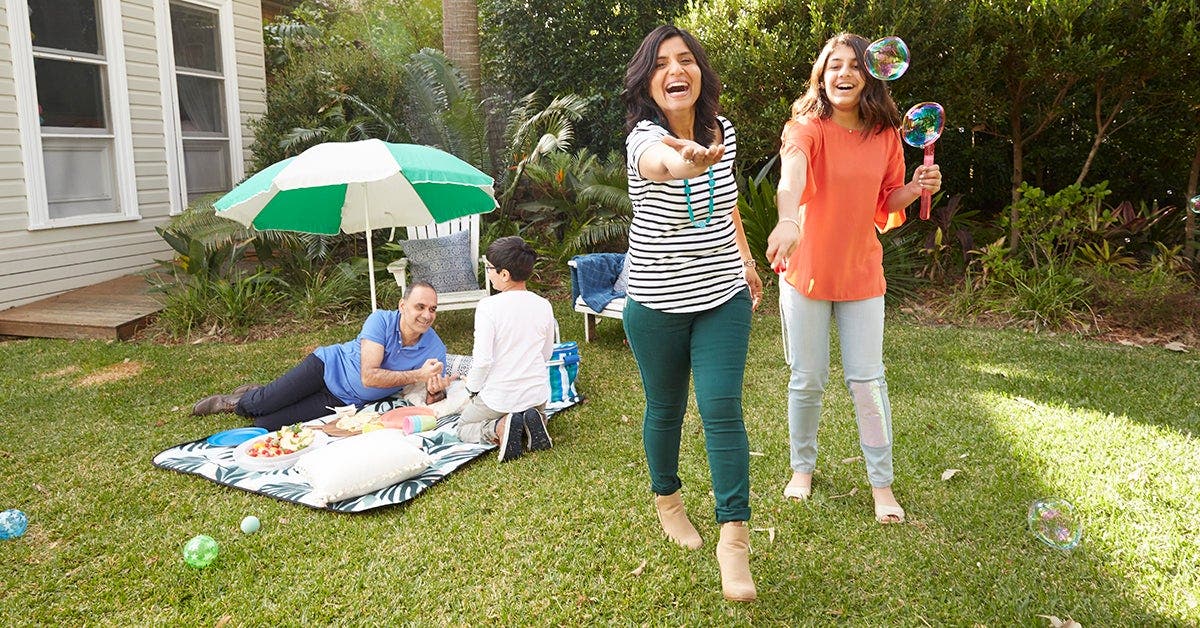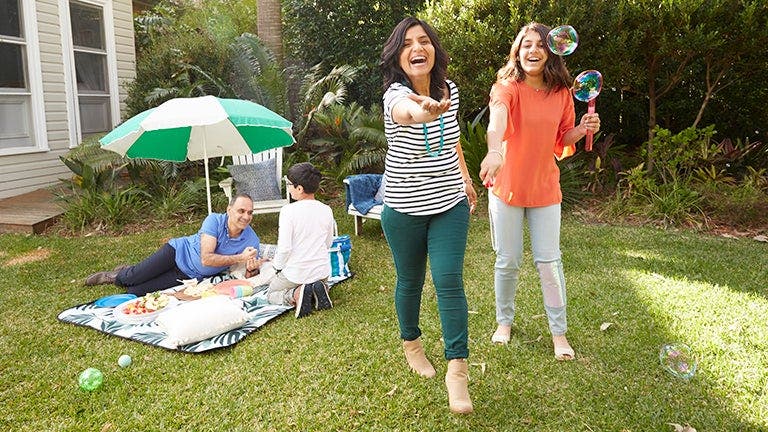8 Ways to Exercise Without Ditching Your Kids


You know the drill: The family that plays together stays together…but it’s also true that they get fit together. Not only can regular family activities boost your gang’s strength and cardiovascular health, they can also bring you closer, promote healthy competition, and add to the store of positive family memories.
And while you can all lace up your sneakers and go for a post-dinner walk or bike ride, thinking outside that same old box can provide inspiration and motivation. We asked family fitness experts for some fresh ideas and twists on the tried and true. These eight ideas will have even the most reluctant family members saying game on.
1. Backyard bubbles
This is ideal for families with the littlest kids, says Stephen J. Virgilio, PhD, professor of physical education at Adelphi University in Garden City, NY, and author of Fitness Education for Children: A Team Approach.
How to play: Head outside with some bubbles (or, even better, an automatic bubble-making toy). Instruct everyone to pop as many bubbles as they can, in time intervals, with different body parts. Think: Elbows! Fingers! Knees! Feet!
Body benefits: Cardio exercise, coordination as you try to hit the bubbles, and—for toddlers—reinforcing body-part ID (which helps them become more comfortable with their bodies and builds interest in physical activity).
2. Fit TV
Stuck indoors? Try a game called Fit TV during which commercials dictate game time, says Virgilio.
How to play: For the duration of every commercial, family members take turns choosing and leading a different exercise for 30 seconds each. Jumping jacks, squats, push-ups, holding a plank. The typical set of commercials can give at least four people time to lead an interval.
Body benefits: Interval training (a burst of heart-pumping exercise followed by a short rest) burns calories.
3. Neighborhood walk ABCs
A sustained stroll around your neighborhood, can be a great way to boost digestion after dinner. For a twist, play a game of ABC.
How to play: Each family member takes a turn identifying something the person sees that starts with the letters of the alphabet. Alternate turns and keep walking until you see something for each letter (OK, maybe you can skip X…).
Body benefits: Brisk walking is great cardio exercise; the longer you walk the more calories you burn. For younger children, it will help improve vocabulary and initial sounds.
4. Beat the wall
The classic court sport may feel out of reach—after all, don’t you have to have lessons, or at least access to a court? Not necessarily, says Joe Curto, president of the Yonkers Tennis Center in Yonkers, NY.
How to play: Grab some tennis balls and rackets and play “beat the wall.” “Take turns hitting off a garage door or outside wall; the goal is to hit the ball on the first bounce or you lose a point,” Curto says. Another idea: Pit pairs of players against each other and see who can keep a volley (hitting the ball back and forth) going the longest.
Body benefits: Tennis promotes agility, cardiovascular endurance, and hand-eye coordination.
5. Pickle
This backyard sport is a mash-up of baseball and dodgeball, says Sara Haley, a pre- and postnatal exercise specialist and mother of three in Santa Monica, CA.
How to play: Set up two bases about 30 yards apart. Two family members are “ends,” standing beside the bases and tossing a soft ball back and forth while everyone else runs between the bases trying not to get nabbed by the ball. If you get hit before you get to base, you’re out. Three hits and you switch places with an “end” at one of the bases.
Body benefits: Everyone will work on speed and agility while getting the heart pumping.
6. Red light, green light…with a twist
You remember this game from your childhood, surely: A leader gives directions to a lineup of challengers facing her. If the leader says “green light,” the challengers move toward her; she halts them with “red light.” Haley’s twist gives this playground staple an athletic edge.
How to play: “Red still means stop, but ‘green’ means sprint, and ‘yellow’ means speed-walk.” Make up your own rules: Purple means bust out a dance move. Black means do five push-ups.
Body benefits: Depends on what you add to your color list of exercises, but it can add cardio endurance, muscle toning, or core strength.
7. Obstacle course
Another simple backyard game is a favorite at Haley’s house. “We set up Hula-Hoops, ball tosses, and even traditional exercises like jumping jacks,” around the yard or at a park.
How to play: This activity could be done either indoors or outdoors. Determine your path and set up stations. Inside: you can crawl under the dining room table, do jumping jacks at the kitchen, do step-ups on the couch, or fun laps on the stairs. Outside: Use Haley’s examples or use a soccer ball to dribble from one station of jumping jacks, push-ups, or twirling to another. Be creative. “Time each other going through the course, and try to beat your own time,” Haley says.
Body benefits: Agility, coordination, cardio and strength conditioning depending on the exercises.
8. H.O.R.S.E. play
You may remember playing this one-on-one basketball game from when you were a kid—in which you added a letter to the word “horse” every time you got a basket. Try Haley’s all-family twist.
How to play: Take turns copying each other’s moves. “Maybe you have to spin around before you shoot, or high-five your sibling. We’ve also done a burpee [an exercise in which you do a squat-thrust to plank position] before shooting.” She also suggests setting up a child-size net so the littlest family members can compete.
Body benefits: Depending on how you set up this game it can be cardio or strength based, as well as teach teamwork, creativity, and hand-eye coordination.
RELATED: The 5 Principles of Making Family Fitness Fun
